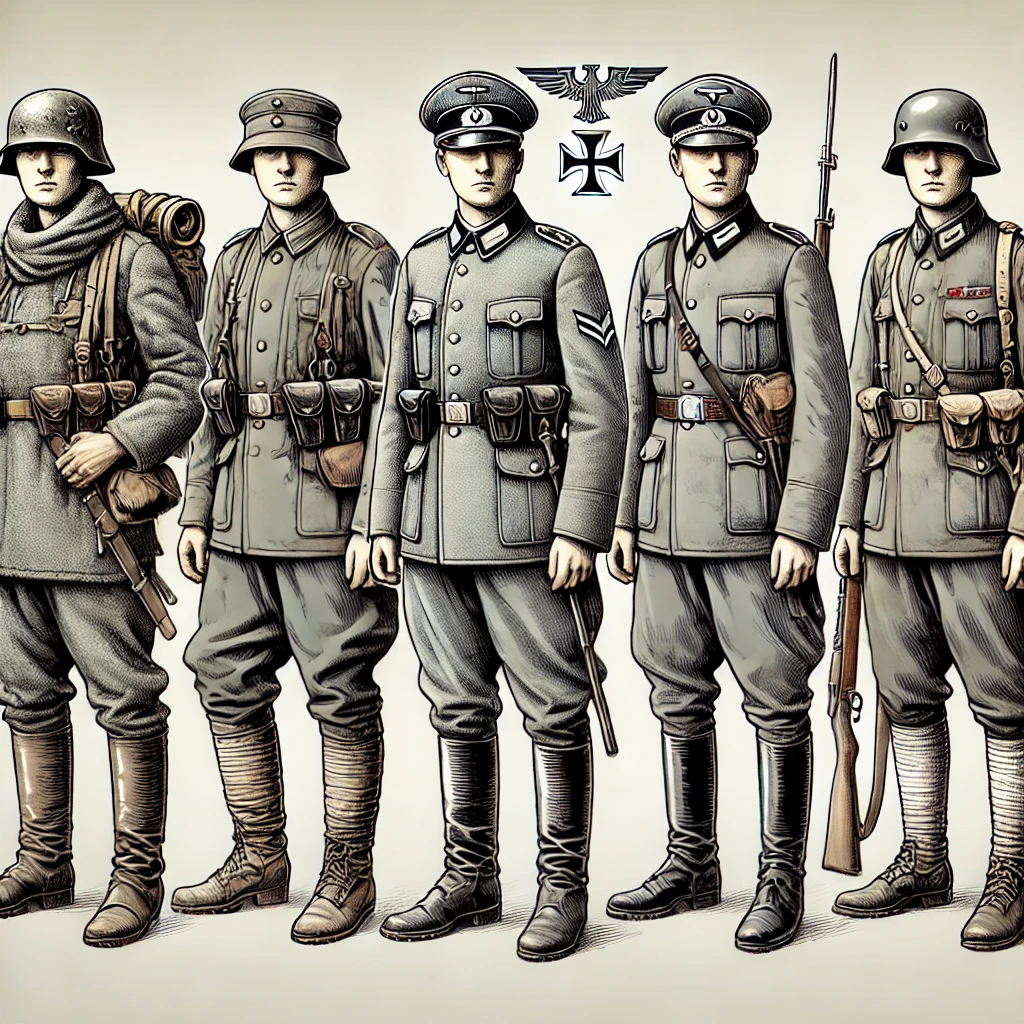
WW1 German Uniforms: How They Changed the Battlefield
Published on Feb 14, 2025
When you think of World War I, images of trench warfare, gas masks, and stoic soldiers often come to mind. Another important part of this historic conflict is the German uniforms worn by these brave men on the battlefield.
The changes in the German WW1 uniform were not only about style. They were important for military strategy and identity.
As we explore German WW1 uniforms, we will see how they showed both practicality and pride. These uniforms also affected combat performance in surprising ways. Get ready to uncover how these iconic outfits changed the face of warfare forever!
world war 2 german uniforms
World War II German uniforms marked a significant shift from their WW1 German Uniforms predecessors. The designs became more streamlined and functional, reflecting the needs of modern warfare. Each branch of the military adopted distinct styles that were both practical and intimidating.
The iconic field gray color emerged during this time, replacing the darker shades used in World War I. This change was not just aesthetic; it provided better camouflage in various environments.
Officers often wore sharp insignias that showed their rank and unit. Soldiers had simple but effective gear for quick movement.
The infamous SS uniforms introduced a blend of authority and fear with their tailored looks, emphasizing discipline within ranks. These uniforms contributed to an image that has become synonymous with WWII history—evoking strong emotions even decades later.
world war 1 german uniforms
World War 1 German uniforms were a striking blend of functionality and military tradition. Craftsmen carefully made each piece to show the pride of the Imperial German Army. The designers created it for both style and usefulness.
The iconic field gray tunic became synonymous with German soldiers during this time. Its muted color helped blend in with the battlefield environment, providing a tactical advantage.
Completing the look were distinctive pickelhaube helmets, adorned with ornate designs that communicated rank and unit affiliation. These helmets not only offered protection but also served as symbols of authority.
As warfare evolved, so did these uniforms. New materials emerged, emphasizing durability while allowing greater mobility on the front lines. Each change mirrored shifts in tactics and technology throughout the war.
With rich symbolism woven into their design, WW1 German uniforms left an indelible mark on military history and culture.
German uniforms ww1
The German uniforms of World War 1 were a striking blend of functionality and symbolism. Designed for the rigors of trench warfare, they featured durable materials that withstood harsh conditions.
Distinctive colors played a significant role. The iconic field gray became synonymous with the German military, providing effective camouflage in various terrains. This strategic choice marked a departure from more vibrant colors used in previous conflicts.
Headgear also evolved during this time. The pickelhaube, or spiked helmet, was popular at the start of the war. However, simpler designs became more common as practicality became more important on the battlefield.
Moreover, insignia and decorations helped differentiate ranks within units. These elements not only conveyed authority but fostered unit pride among soldiers facing immense challenges together. Each uniform told a story of bravery in chaos. It showed the wearers' strength during one of history’s deadliest wars.
German soldier uniform
The German soldier uniform during WW1 was a striking representation of military tradition. With its unique colors and materials, it shaped how people saw soldiers both on and off the battlefield.
Typically made from wool, these uniforms offered durability in various weather conditions. The feldgrau color, a blend of gray and green, helped camouflage troops against both natural landscapes and urban environments.
Each component had purpose; tunics often featured brass buttons that added an element of distinction while maintaining functionality. Trousers were designed to be practical yet comfortable for long marches.
Headgear also played a vital role. The pickelhaube is a famous spiked helmet. Not only was it decorative, but it also served as a symbol of pride for German forces. It became synonymous with the image of the disciplined German soldier.
Footwear was equally important, crafted to endure rigorous movement across diverse terrains without sacrificing comfort.
ww1 German soldier uniform
The WW1 German soldier uniform was a distinctive and significant element of military history. The designers created these uniforms for function as much as for form, embodying the spirit of their time.
One notable feature was the pickelhaube, or spiked helmet, which became an iconic symbol of the Prussian army. While it offered some protection, it also made soldiers easily recognizable on the battlefield. Craftsmen usually made the tunics from wool, providing warmth in harsh conditions while ensuring practicality for mobility.
Colors played a crucial role too. The feldgrau (field gray) became standard towards the war's end, offering better camouflage compared to earlier bright colors. This shift marked a turning point in how military strategies adapted to modern warfare’s demands.
Footwear was essential; sturdy boots were vital for endurance during long marches and combat situations. Soldiers often wore leather gaiters over their pants. This helped protect their legs from mud and debris. These were common problems in trench warfare.
Each piece worn by these soldiers told stories of bravery and hardship endured on battlefields across Europe. The evolution of German uniforms during WW1 showed changes in military tactics. These changes also left lasting impressions that influenced future designs worldwide.
